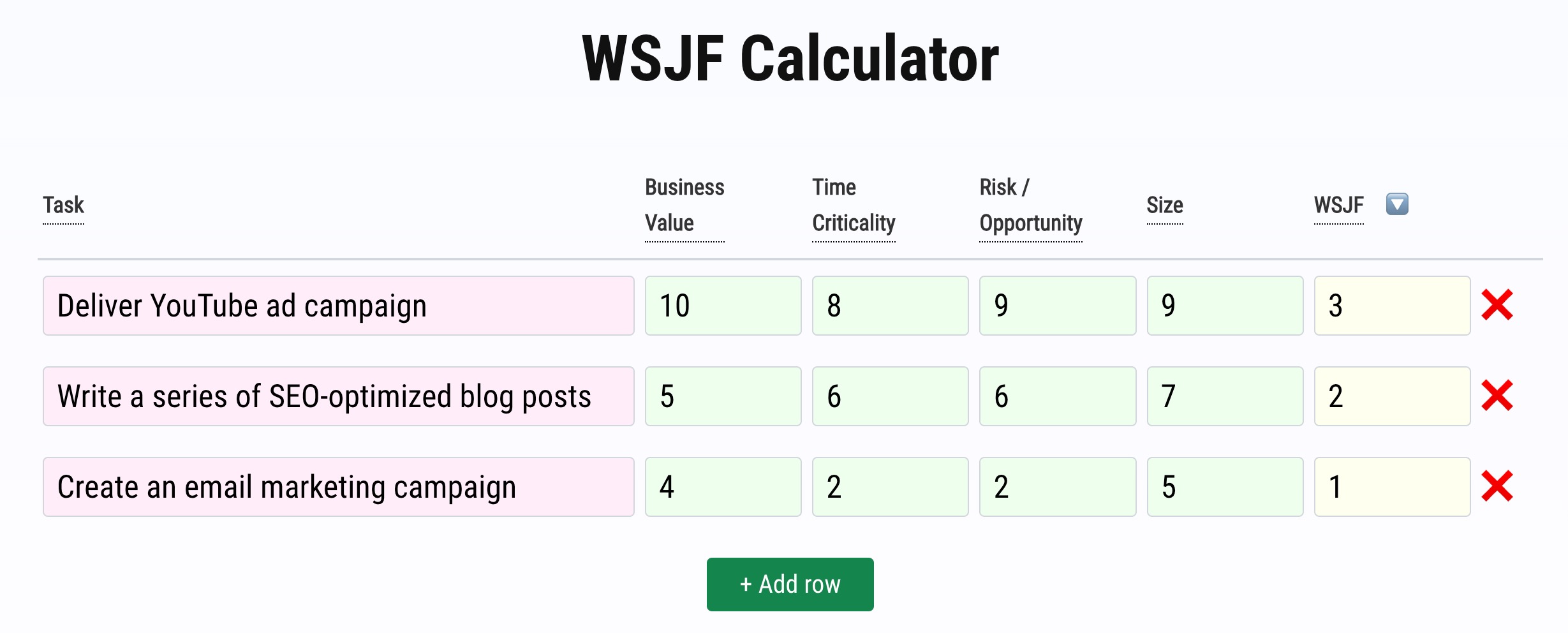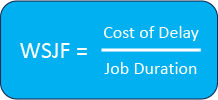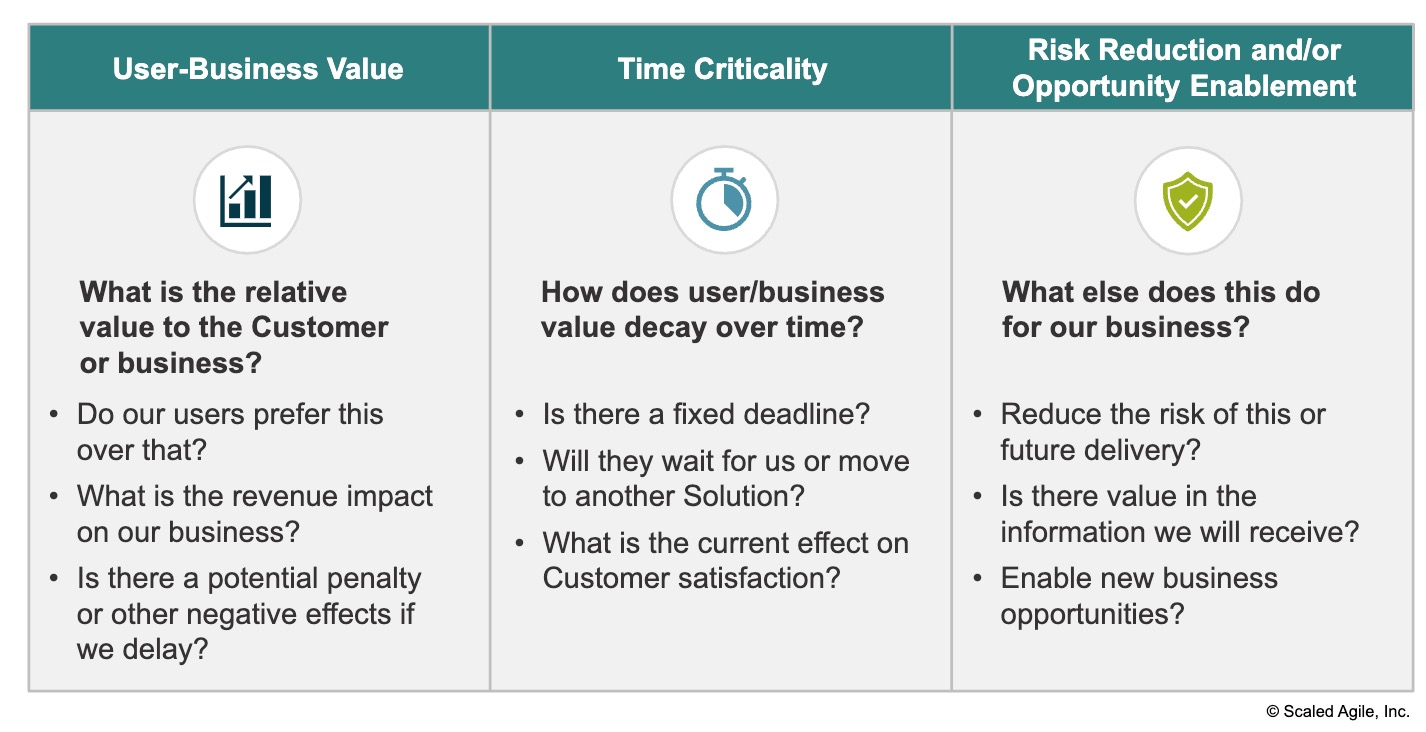
WSJF represents a third approach to prioritization as an alternative to the ICE method of prioritization and the MoSCoW method of prioritization that we’ve covered in previous blog posts.
What is WSJF Prioritization?
WSJF stands for Weighted Shortest Job First. It is a tool used in the Scaled Agile Framework (SAFe), primarily by product teams to decide which features to implement first. It can also be used by marketing teams.
WSJF differs from ICE and MoSCoW by being explicit about introducing the concept of economic value in the prioritization equation, as well as introducing the concept of the Cost of Delay (COD).

While the formula for WSJF is simple, the Cost of Delay divided by the Job Duration (as shown above), in practice, it requires a calculation involving four factors. The full formula is User/Business Value + Time Criticality + Risk Reduction divided by Job Duration, as shown below.

Using WSJF
According to Scaled Agile, the three Cost of Delay elements should be calculated by assigning a score from 1-10 for each of the elements. These scores should be arrived at by the marketing team or the product/marketing owner asking and answering the following questions for each of the elements of Cost of Delay:

Job Duration is also assigned a value from 1 to 10, where 1 represents jobs with short duration, and 10 represents jobs that will require the longest duration. Job size (XS, S, M, L, XL) can be used as a proxy for job duration, although it is not a perfect proxy. For example, a job may be small but may require specialist skills that won’t be available for a long time. Or a job may be large but the skills to get it done are plentiful, and by having multiple people work on it at once, the job duration may be relatively short.
Once values on a scale of 1 to 10 are assigned to all four elements, the WSJF score can be calculated using an online WSJF calculator or by simply creating a formula in a spreadsheet. Items with the highest score are the highest priority.
Like MoSCoW, although not for the same reasons, WSJF tends to put tasks into four different buckets, generally ranked in this order:
- Short duration tasks that also have high business/user value
- Longer duration tasks that have high business/user value
- Moderate duration tasks that have lesser business/user value
- Longer duration tasks that have lesser business value
Advantages of WSJF
A Very Complete Approach to Prioritization
If a marketing team answers all of the questions listed above in the Scaled Agile list of the elements of Cost of Delay, the team will have a complete view of the importance of a given item of work. While both ICE and MoSCoW look at elements of user and business value, they don’t tend to look at time criticality or risk reduction and opportunity enablement. They also don’t ask the explicit question, “What is the cost if we delay doing this?”
Consistency
If the team asks all of the questions above and is consistent in its assignment of value on a scale of 1 to 10, the result will be a very consistent approach to prioritization. It is also possible to justify to stakeholders the priorities, as long as they have input into the elements of calculating the Cost of Delay.
Takes into Account Skill Set Constraints and Dependencies
Two tasks that have the same Impact, Confidence, and Ease of execution using the ICE method may actually take very different durations to get done because of lack of availability of a particular skill set or dependencies that can cause a delay. WSJF takes this into account in a way that neither ICE or MoSCoW do not.
Rigor
When done correctly, WSJF has more rigor than either ICE or WSJF and can produce results that are more in line with the real economic benefit balanced against resource availability and dependencies.
Disadvantages of WSJF
Complexity
Answering all of the questions for each element and calculating skill set availability and dependencies adds a level of complexity to the calculation. For this reason, WSJF is better suited to prioritizing big initiatives or major investments at a QBR than at prioritizing the tasks of a weekly backlog.
Prioritizes Short-Term Wins over Long-Term Investments
Certain forms of innovation that may require long-term investments for uncertain gain will almost never get prioritized using the WSJF method, even though some long-term investments end up delivering the highest levels of value. The Dyson vacuum cleaner, the light bulb, and the mobile phone are all inventions that would never have been prioritized using WSJF because they either required too many failures (the Dyson vacuum and the light bulb) or the perceived market value was greatly under-estimated at the time (the mobile phone).
Scores Can Be Subjective
Any time that you have teams assigning scores from 1-10 to complex decisions, you’re introducing a degree of subjectivity. If the team isn’t rigorous in asking the right questions and consistent in their assignment of values based on the answers to those questions, the prioritization will be subjective.
Conclusion
WSJF is an alternative approach for setting priorities. It is particularly useful when making big decisions or deciding between several potential big investments. Marketers should be aware of WSJF as a tool for prioritization and use it in the right circumstances.

